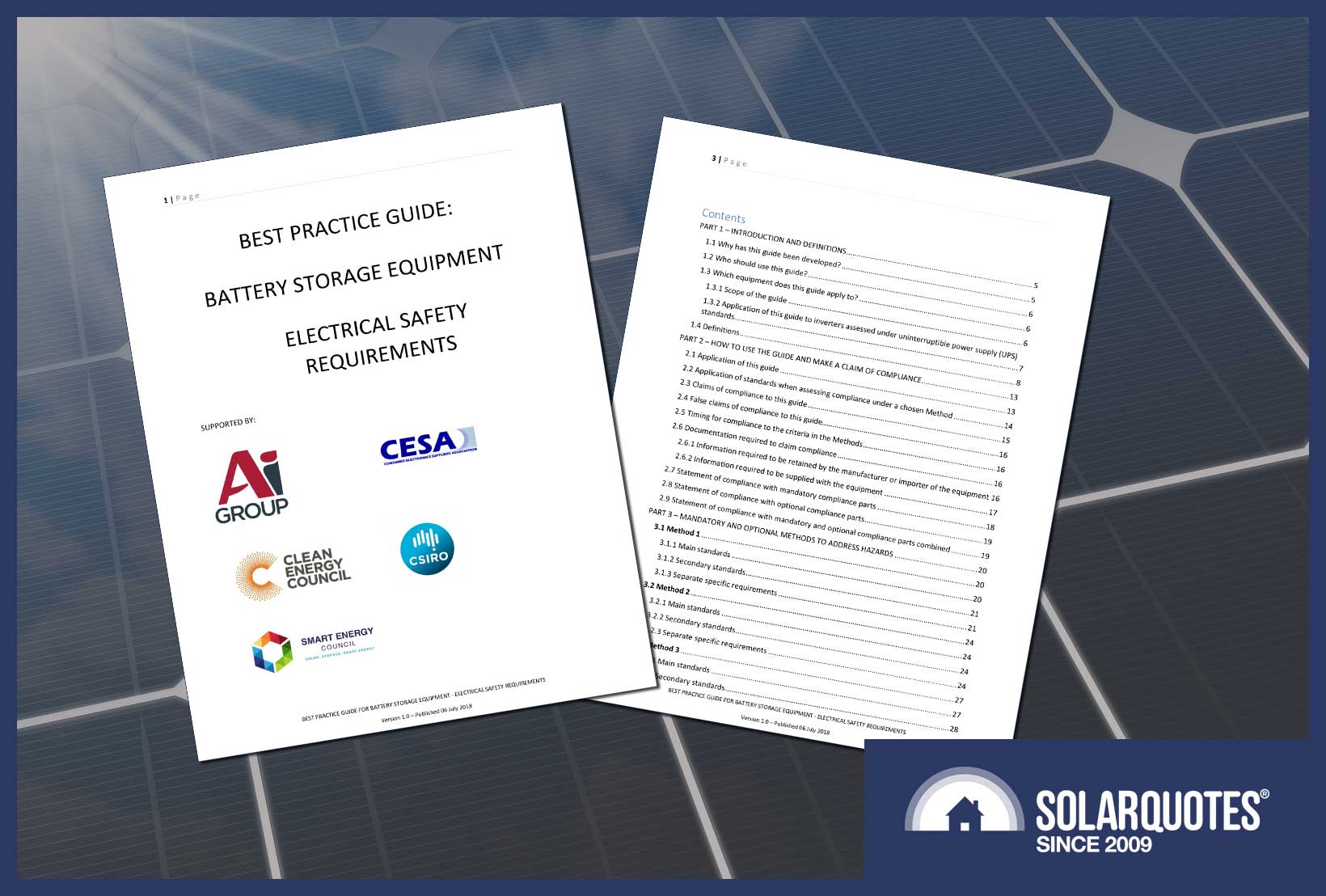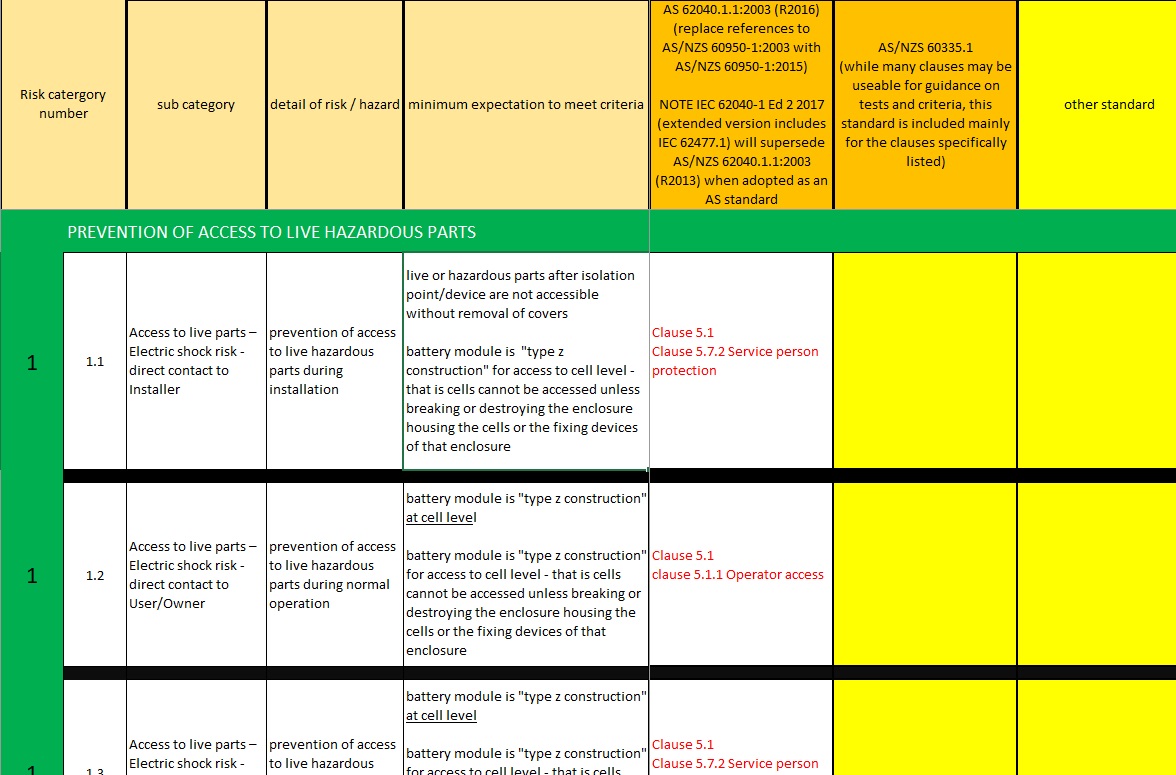
“Best Practice Guide: Battery Storage Equipment — Electrical Safety Requirements.” What’s In It And Who’s It For?
In July 2018 the “Best Practice Guide: Battery Storage Equipment — Electrical Safety Requirements” was published. This was a momentous event in the history of battery safety guides and I can remember exactly where I was when I heard the news. I was in Australia1. Before this day there was no specific product safety guide covering lithium home batteries. But now, in our time of need, it is here.
The guide exists because there was a need for clear and consistent safety criteria for residential lithium battery systems. While existing standards already applied it was important to develop one clear and consistent set of safety criteria so everyone would be on the same page — or the same set of 40 pages.
What The Guide Is For
The guide is made for manufacturers and importers so they can ensure battery systems they make or bring into the country meet minimum safety standards. The report says:
“By applying the safety criteria, manufacturers and importers can demonstrate that their equipment meets the minimum acceptable level for safety for installation in household environments and provides an acceptable level for safety for installation in household environments and provides an acceptable measure of protection against hazards such as electrical, mechanical, thermal, fire and radiation.”
Having one best practice guide should make suppliers jobs easier and will hopefully reduce the cost of home battery storage in Australia by a small, but still helpful, amount.
Who The Guide Is For
Because most of us aren’t in the habit of manufacturing home battery storage systems or shipping container loads of them over from China, South Korea, the USA, or other weird countries; the guide isn’t going to be of direct interest to a lot of people. If you are a home owner looking for a battery system it’s not going to help you select one suitable for your needs. But if you are interested in the technical aspects of battery system safety don’t let me put you off reading it. It’s 40 pages jammed packed with words. And not just words, but also punctuation. Just when you think one sentence has come to a full stop another one starts up. It was so riveting I hardly fell asleep at all.
The guide is more valuable to installers who can use it to check if battery systems they work with are up to scratch with regard to safety and can allow them identify areas that may need improvement. More generally, they can use the information and principles in the guide to determine if battery storage is safe to install in specific situations.
Who Made The Guide
The best practice guide was developed by various stakeholders. These included but weren’t limited to:
- Australian Industry Group
- Australian Consumer Electronics Suppliers Association
- Clean Energy Council
- CSIRO
- Energy Networks Australia
- Smart Energy Council
The development process consisted of people from various backgrounds who understand electrons2 and stuff working together to hammer out a suitable standard using their pooled expertise.
This standard making process doesn’t always result in perfection, but I can’t think of a better way to go about it apart from making sure the results are easily accessible — which has been done in this case.

Here we see a highly motivated stakeholder.
Battery Systems Covered
The guide applies to batteries that are:
- For residential use
- Contain lithium
- Have a storage capacity from 1 to 200 kilowatt-hours
- Are permanently wired in and not portable or mobile
This means the guide doesn’t apply to your laptop or electric car. Not unless your laptop is very strange and your electric car has limited range.
It’s hard to imagine a home needing 200 kilowatt-hours of lithium battery storage. That amount seems more suitable for a reasonably large business. But I suppose it’s possible someone with a large mansion may want to cut themselves off from the rest of the world. Malcolm Turnbull maybe.

“Still richer than you, Ronald!” (Image: The Daily Telegraph)
Some Guide Highlights
The guide has a lot of information on how manufacturers and importers can make sure battery systems are compliant and which particular Australian standards may apply. I did not find these parts of the report interesting and won’t go into them. But please feel free to read them yourself. Go on — I dare you.
What I will do instead is make a list of not so boring points which I have selected from the guide based upon the criteria that I didn’t fall asleep while reading them:
- If a battery system’s external enclosure is metallic it must be no less than 0.2mm in thickness. This is important because unless it’s good quality steel I could poke my finger through that3.
- Battery modules must be sealed so they cannot be opened without breaking them. This is so they can be returned safely to the manufacturer to be safely serviced. Opening a battery incorrectly can cause a sudden increase in entropy, which is science talk for things going pear shaped.
- Detailed Safety Datasheets and installation instructions must be supplied.
- If a system can be located outside its markings must be UV resistant.
- After 12 months they will review if battery systems that can be installed indoors will be required to resist an external fire. They will also review if battery systems that can be located outdoors will be required to resist seaside salt mist corrosion.
- It has a risk matrix you can download here. This is a large table that lists different hazards associated with battery systems, minimum requirements to meet the safety criteria, and where to find relevant sections of Australian standards. Here’s a small part of it:
Whoops! Wrong Matrix! Here’s the right one:
There — isn’t this much more exciting than some boring movie full of explosions and kung-fu and gunfights and exploding kung-fu gunfights?
I Have Nothing More To Say
In all seriousness, if you are seriously interested in the serious matter of battery safety you are going to have to read the report yourself. But if this brief article has convinced you reading it isn’t necessary then I’ve saved you from 40 boring pages. Or more like 8 boring pages and a long nap.
Footnotes
- Actually, I can remember exactly where I was when Harold Holt shot J.F.K. while landing on the moon in an exploding Space Shuttle. But I’m taking pills for that now. ↩
- Given what particle physics is like, rather than understand electrons, it’s more likely they fail to understand electrons in the correct way. ↩
- Mind you, I’m not normal. The reason why European DNA is only around 2% Neanderthal is because my family kept most of the Neanderthal genes for themselves. ↩



 RSS - Posts
RSS - Posts



Are you taking the pills, because you can remember stuff from the 1960’s, or, to cope with what happened during the 1960’s?
Weren’t lifeguards invented in the 1960’s, to find the owners of suits left on beaches?
I thought that it was Nixon, riding in one of those helicopters with the stereo turned up, plaing We Got To Get Out Of This Place”, that shot JFK, when Nixon was aiming at the rushin fighter plane, Air Force One.
I understood that it is said that people who say they remember the 1960’s, weren’t really there (although, from what I have heard, with some of the chemicals (like lysergic acid diethylamide), that people liked to absorb, some people believed that they were in all kinds of places, with all kinds of things happening around them, and, for a couple, that some things seemed to be “very green”).
That is probably why those strange people were taking those lumps of black stuff into the chamber of the feral parliament – they probably thought it was “take your children to work day”, and, with what they appear to be on, in there, they probably thought the lumps of black stuff, were their children, and that may be why they seemed to be so affectionate toward the lumps of black stuff.
If we ever meet I’ll give you some of my pills if you give me some of yours.
Harold Holt, eh Ronald; stop with the pills, we need you in tip-top, sharpest form. I know you’re truly a rebel in the land down under! Actually, the “Dixie Mafia” with Lyndon B. Johnson and lieutenants like H.W. Bush of the CIA were most likely involved. Bush was in Dallas. Oswald was the patsy. JFK had threatened to break up the CIA in pieces, plus he had an executive order to audit the cabal of bankers we call the Federal Reserve which is neither Federal nor does it have any reserves. He also wouldn’t give nukes to Israel, so even the Mossad is rumored. Sad, how absolute power corrupts absolutely, but with solar and storage, the common people may just achieve energy freedom yet from the evil forces. Here in the States, we have until 2021 to install solar and still receive a 30% tax credit, so we’re going to see a gold-rush for solar over the next few years. Cheers, mate!
Ronald – I think you would not want these pills that I am taking.
Increasingly, when I watch television, I am seeing more of these horrible alien life forms that are named members of parliament. They make the Gremlins seem like nice people.
It is getting more like the little girl in the Poltergeist movie, when she said “They’re back…”.
So, with me increasingly seeing these horrible alien creatures, when I am watching television, I think that you would not want these pills that I am taking.
“must be no less than 0.2mm in thickness.”
I imagine my kids would also have no problems poking their fingers through a metal sheet 0.2mm thick, so this is probably a good thing.
Personally I’d hope they make it at least an order of magnitude thicker than that. 😉
To be fair, 0.2 mm steel is generally finger proof for homo sapiens. This video doesn’t show its strength, but does let you see what it looks like:
However, it just says “metallic” so I suppose it would be possible to have a gold battery case 0.2mm thick which would not be very strong. But on the bright side it’s not going to rust.
My neighbours trees are shading out my solar panels and have been doing so for over three yeras. My electricty bills clearly show a lineal reduction in my infeed to the grid and I am losing around $3,000 a year. QCAT hired an arborist “expert” and charged us both $500.00 each and wanted to charge us another $400.00 which i objected to as a pensioner. I believe they have punished me for that. The “exp[ert” is no expert and has made huge errors including stating the trees would only grow to 6 metres high. They are already at 8 metrres and as they are tea trees fire authorities in WA ,SA, Victoria, Tasmania and some QLD councils are saying do not plant them because they become exploding fire balls in a fire due to their oil content> I am looking for anyone that may have had the same problem or a similar case.
I don’t think there’s much you can do at the moment Richard.
Depending on what and how much other stuff your neighbour has growing in his garden maybe ‘drought’ and ‘water shortage’ might change his thinking, perhaps quicker than you think.
These days, local councils are rapidly becoming more aware of ‘fire hazard’ risk’, especially in rural areas. Depends where you live of course, but maybe it might be worthwhile to talk to your local council. Maybe you can find some local councils ‘somewhere else’ in Australia that specifically identify on some council guideline document that teatree and other vegetation and trees as being ‘definitely not recommended’ because of potential fire hazard risk .
Once you’ve got your hands on some written documentation, that would be the time to ‘diplomatically’ pass the info onto your neighbour. Also, you can check with Bureau of Meteorology – their website should have the prevailing wind directions at your location eg where I live, a significant portion – about 48% consistently comes from one direction, if that direction would cause any fire to be highly likely to blow towards your neighbours house (not yours), that would be something else you could throw into the info you pass on to him.
Do ALL your panels face North?. Might be economically worthwhile to investigate moving some to the West or East, especially if doing so would give you a $1500 to $2000 additional benefit per year.